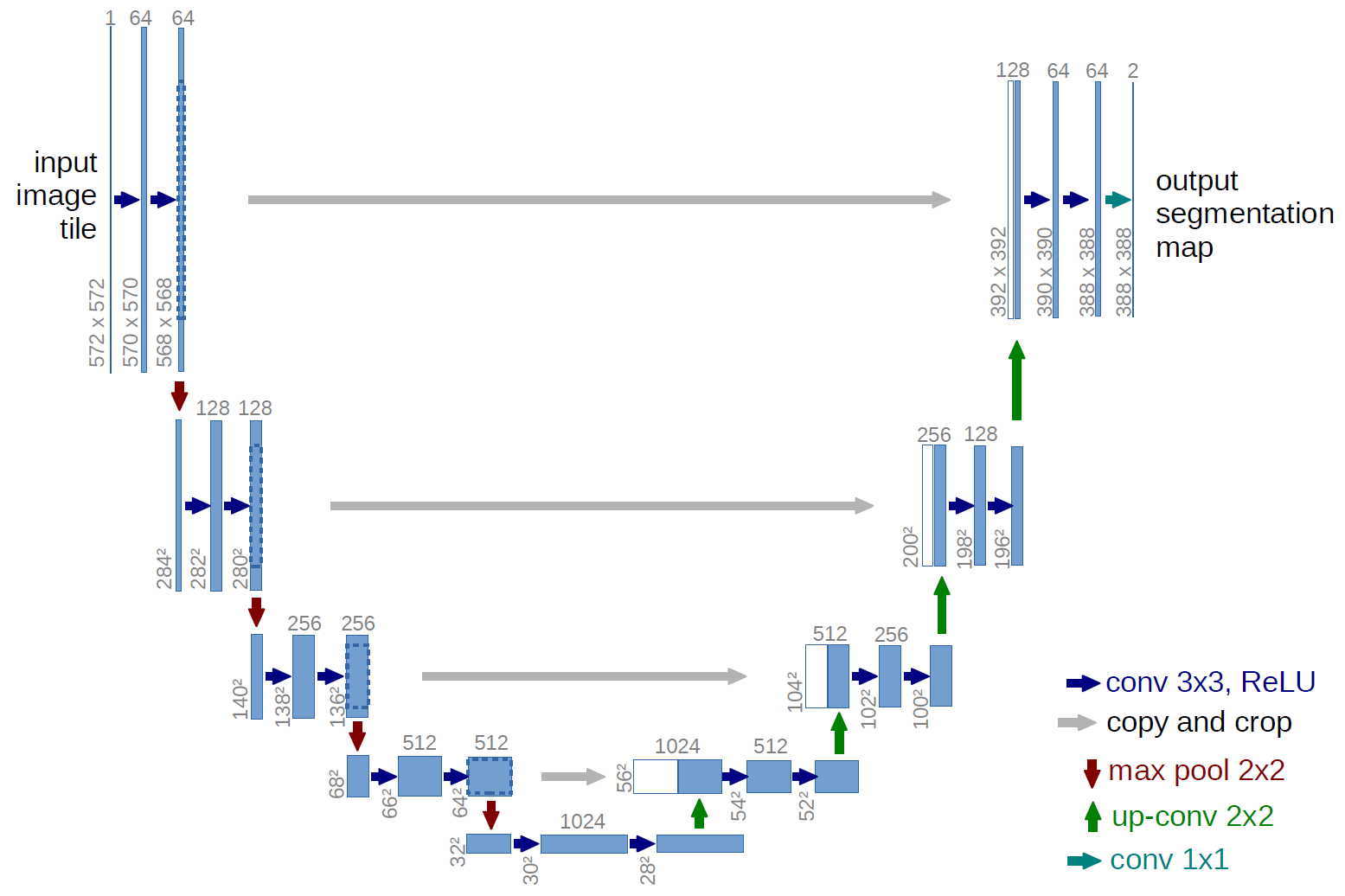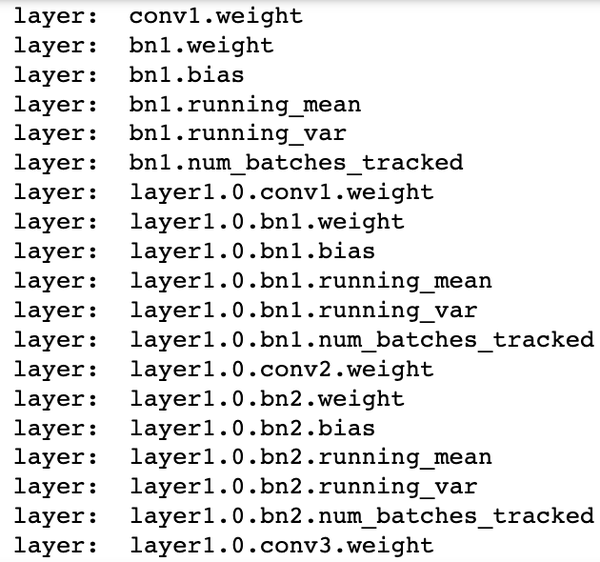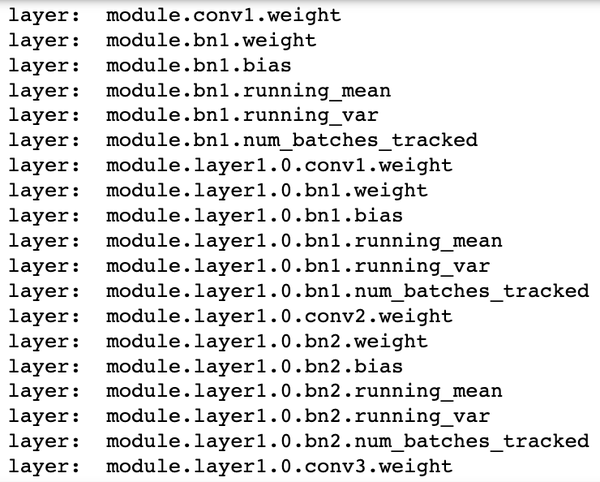第五章:PyTorch模型定义
1、PyTorch中模型定义的三种方式
Pytorch构建模型, 常用的方式有下面的三种:
- 继承nn.Module基类构建自定义模型
- 使用nn.Sequential按层顺序构建模型
- 继承nn.Module基类构建模型,并辅助应用模型容器进行封装
Sequential适用于快速验证结果,因为已经明确了要用哪些层,直接写一下就好了,不需要同时写__init__和forward;ModuleList和ModuleDict在某个完全相同的层需要重复出现多次时,非常方便实现,可以”一行顶多行“。当我们需要之前层的信息的时候,比如 ResNets 中的残差计算,当前层的结果需要和之前层中的结果进行融合,一般使用 ModuleList/ModuleDict 比较方便。
Module 类是 torch.nn 模块里提供的一个模型构造类 (nn.Module),是所有神经⽹网络模块的基类,我们可以继承它来定义我们想要的模型
PyTorch模型定义应包括两个主要部分:
- 各个部分的初始化(init)
- 数据流向定义(forward)
(1)继承nn.Module基类构建自定义模型
模型中用到的层一般在__init__函数中定义,然后再forward方法中定义模型的正向传播逻辑。类似于keras里面的Model方法
class Net(nn.Module):
def __init__(self):
super(Net, self).__init__()
self.conv1 = nn.Conv2d(in_channels=3,out_channels=32,kernel_size = 3)
self.pool1 = nn.MaxPool2d(kernel_size = 2,stride = 2)
self.conv2 = nn.Conv2d(in_channels=32,out_channels=64,kernel_size = 5)
self.pool2 = nn.MaxPool2d(kernel_size = 2,stride = 2)
self.dropout = nn.Dropout2d(p = 0.1)
self.adaptive_pool = nn.AdaptiveMaxPool2d((1,1))
self.flatten = nn.Flatten()
self.linear1 = nn.Linear(64,32)
self.relu = nn.ReLU()
self.linear2 = nn.Linear(32,1)
self.sigmoid = nn.Sigmoid()
def forward(self,x):
x = self.conv1(x)
x = self.pool1(x)
x = self.conv2(x)
x = self.pool2(x)
x = self.dropout(x)
x = self.adaptive_pool(x)
x = self.flatten(x)
x = self.linear1(x)
x = self.relu(x)
x = self.linear2(x)
y = self.sigmoid(x)
return y
net = Net()
print(net)
summary(net, input_shape=(3, 32, 32))

(2)使用nn.Sequential按层顺序构建模型
使用Sequential定义模型的好处在于简单、易读,同时使用Sequential定义的模型不需要再写forward,因为顺序已经定义好了。但使用Sequential也会使得模型定义丧失灵活性,比如需要在模型中间加入一个外部输入时就不适合用Sequential的方式实现。使用时需根据实际需求加以选择。
class MySequential(nn.Module):
from collections import OrderedDict
def __init__(self, *args):
super(MySequential, self).__init__()
if len(args) == 1 and isinstance(args[0], OrderedDict): # 如果传入的是一个OrderedDict
for key, module in args[0].items():
self.add_module(key, module)
# add_module方法会将module添加进self._modules(一个OrderedDict)
else: # 传入的是一些Module
for idx, module in enumerate(args):
self.add_module(str(idx), module)
def forward(self, input):
# self._modules返回一个 OrderedDict,保证会按照成员添加时的顺序遍历成
for module in self._modules.values():
input = module(input)
return input
Sequential定义模型,只需要将模型的层按序排列起来即可,根据层名的不同,排列的时候有两种方式:
- 利用变长参数直接排列:这种方式构建时不能给每个层指定名称
import torch.nn as nn
net = nn.Sequential(
nn.Linear(784, 256),
nn.ReLU(),
nn.Linear(256, 10),
)
print(net)
Sequential(
(0): Linear(in_features=784, out_features=256, bias=True)
(1): ReLU()
(2): Linear(in_features=256, out_features=10, bias=True)
)
- 利用OrderedDict
import collections
import torch.nn as nn
net2 = nn.Sequential(collections.OrderedDict([
('fc1', nn.Linear(784, 256)),
('relu1', nn.ReLU()),
('fc2', nn.Linear(256, 10))
]))
print(net2)
Sequential(
(fc1): Linear(in_features=784, out_features=256, bias=True)
(relu1): ReLU()
(fc2): Linear(in_features=256, out_features=10, bias=True)
)
- 利用add_module方法
net = nn.Sequential()
net.add_module("conv1",nn.Conv2d(in_channels=3,out_channels=32,kernel_size = 3))
net.add_module("pool1",nn.MaxPool2d(kernel_size = 2,stride = 2))
net.add_module("conv2",nn.Conv2d(in_channels=32,out_channels=64,kernel_size = 5))
net.add_module("pool2",nn.MaxPool2d(kernel_size = 2,stride = 2))
net.add_module("dropout",nn.Dropout2d(p = 0.1))
net.add_module("adaptive_pool",nn.AdaptiveMaxPool2d((1,1)))
net.add_module("flatten",nn.Flatten())
net.add_module("linear1",nn.Linear(64,32))
net.add_module("relu",nn.ReLU())
net.add_module("linear2",nn.Linear(32,1))
net.add_module("sigmoid",nn.Sigmoid())
print(net)
当模型的前向计算为简单串联各个层的计算时,Sequential 类可以通过更加简单的方式定义模型。它可以接收一个子模块的有序字典(OrderedDict) 或者一系列子模块作为参数来逐一添加 Module 的实例,⽽模型的前向计算就是将这些实例按添加的顺序逐⼀计算。这个就类似于keras里面的sequence方法。
(3)nn.ModuleList()
ModuleList 接收一个子模块(或层,需属于nn.Module类)的列表作为输入,然后也可以类似List那样进行append和extend操作。同时,子模块或层的权重也会自动添加到网络中来。
net = nn.ModuleList([nn.Linear(784, 256), nn.ReLU()])
net.append(nn.Linear(256, 10)) # # 类似List的append操作
print(net[-1]) # 类似List的索引访问
print(net)
Linear(in_features=256, out_features=10, bias=True)
ModuleList(
(0): Linear(in_features=784, out_features=256, bias=True)
(1): ReLU()
(2): Linear(in_features=256, out_features=10, bias=True)
)
但是,nn.ModuleList 并没有定义一个网络,它只是将不同的模块储存在一起。ModuleList中元素的先后顺序并不代表其在网络中的真实位置顺序,需要经过forward函数指定各个层的先后顺序后才算完成了模型的定义。具体实现时用for循环即可完成:
class model(nn.Module):
def __init__(self, ...):
super().__init__()
self.modulelist = ...
...
def forward(self, x):
for layer in self.modulelist:
x = layer(x)
return x
(4)nn.ModuleDict()
ModuleDict和ModuleList的作用类似,只是ModuleDict能够更方便地为神经网络的层添加名称。
net = nn.ModuleDict({
'linear': nn.Linear(784, 256),
'act': nn.ReLU(),
})
net['output'] = nn.Linear(256, 10) # 添加
print(net['linear']) # 访问
print(net.output)
print(net)
Linear(in_features=784, out_features=256, bias=True)
Linear(in_features=256, out_features=10, bias=True)
ModuleDict(
(act): ReLU()
(linear): Linear(in_features=784, out_features=256, bias=True)
(output): Linear(in_features=256, out_features=10, bias=True)
)
(5)继承nn.Module基类构建模型并辅助应用模型容器进行封装
当模型的结构比较复杂的时候, 我们可以应用模型容器(nn.Sequential, nn.ModuleList, nn.ModuleDict)对模型的部分结构进行封装, 这样做会让模型整体更加有层次感, 有时候也能减少代码量。关于这几个模块的介绍, 可以参考下面的第二个链接。
- nn.Sequential 作为模型容器
class Net(nn.Module):
def __init__(self):
super(Net, self).__init__()
self.conv = nn.Sequential(
nn.Conv2d(in_channels=3,out_channels=32,kernel_size = 3),
nn.MaxPool2d(kernel_size = 2,stride = 2),
nn.Conv2d(in_channels=32,out_channels=64,kernel_size = 5),
nn.MaxPool2d(kernel_size = 2,stride = 2),
nn.Dropout2d(p = 0.1),
nn.AdaptiveMaxPool2d((1,1))
)
self.dense = nn.Sequential(
nn.Flatten(),
nn.Linear(64,32),
nn.ReLU(),
nn.Linear(32,1),
nn.Sigmoid()
)
def forward(self,x):
x = self.conv(x)
y = self.dense(x)
return y
net = Net()
print(net)
- nn.ModuleList作为模型容器
注意, 下面中的ModuleList不能用python中的列表代替。
class Net(nn.Module):
def __init__(self):
super(Net, self).__init__()
self.layers = nn.ModuleList([
nn.Conv2d(in_channels=3,out_channels=32,kernel_size = 3),
nn.MaxPool2d(kernel_size = 2,stride = 2),
nn.Conv2d(in_channels=32,out_channels=64,kernel_size = 5),
nn.MaxPool2d(kernel_size = 2,stride = 2),
nn.Dropout2d(p = 0.1),
nn.AdaptiveMaxPool2d((1,1)),
nn.Flatten(),
nn.Linear(64,32),
nn.ReLU(),
nn.Linear(32,1),
nn.Sigmoid()]
)
def forward(self,x):
for layer in self.layers:
x = layer(x)
return x
net = Net()
print(net)
- nn.ModuleDict作为模型容器
注意下面中的ModuleDict不能用Python中的字典代替。
class Net(nn.Module):
def __init__(self):
super(Net, self).__init__()
self.layers_dict = nn.ModuleDict({"conv1":nn.Conv2d(in_channels=3,out_channels=32,kernel_size = 3),
"pool": nn.MaxPool2d(kernel_size = 2,stride = 2),
"conv2":nn.Conv2d(in_channels=32,out_channels=64,kernel_size = 5),
"dropout": nn.Dropout2d(p = 0.1),
"adaptive":nn.AdaptiveMaxPool2d((1,1)),
"flatten": nn.Flatten(),
"linear1": nn.Linear(64,32),
"relu":nn.ReLU(),
"linear2": nn.Linear(32,1),
"sigmoid": nn.Sigmoid()
})
def forward(self,x):
layers = ["conv1","pool","conv2","pool","dropout","adaptive",
"flatten","linear1","relu","linear2","sigmoid"]
for layer in layers:
x = self.layers_dict[layer](x)
return x
net = Net()
print(net)
2、利用模型块快速搭建复杂网络——以U-Net为例
对于大部分模型结构(比如ResNet、DenseNet等),我们仔细观察就会发现,虽然模型有很多层, 但是其中有很多重复出现的结构。考虑到每一层有其输入和输出,若干层串联成的”模块“也有其输入和输出,如果我们能将这些重复出现的层定义为一个”模块“,每次只需要向网络中添加对应的模块来构建模型,这样将会极大便利模型构建的过程。
(1)U-Net

U-Net模型具有非常好的对称性,从上到下分为若干层,每层由左侧和右侧两个模型块组成,每侧的模型块与其上下模型块之间有连接;同时位于同一层左右两侧的模型块之间也有连接,称为“Skip-connection”。此外还有输入和输出处理等其他组成部分。由于模型的形状非常像英文字母的“U”,因此被命名为“U-Net”。
组成U-Net的模型块主要有如下几个部分:
- 每个子块内部的两次卷积(Double Convolution)
- 左侧模型块之间的下采样连接,即最大池化(Max pooling)
- 右侧模型块之间的上采样连接(Up sampling)
- 输出层的处理
除模型块外,还有模型块之间的横向连接,输入和U-Net底部的连接等计算,这些单独的操作可以通过forward函数来实现。
(2)用PyTorch实现U-Net模型块
四个模型块,根据功能我们将其命名为:DoubleConv, Down, Up, OutConv。
import torch
import torch.nn as nn
import torch.nn.functional as F
- DoubleConv
class DoubleConv(nn.Module):
"""(convolution => [BN] => ReLU) * 2"""
def __init__(self, in_channels, out_channels, mid_channels=None):
super().__init__()
if not mid_channels:
mid_channels = out_channels
self.double_conv = nn.Sequential(
nn.Conv2d(in_channels, mid_channels, kernel_size=3, padding=1, bias=False),
nn.BatchNorm2d(mid_channels),
nn.ReLU(inplace=True),
nn.Conv2d(mid_channels, out_channels, kernel_size=3, padding=1, bias=False),
nn.BatchNorm2d(out_channels),
nn.ReLU(inplace=True)
)
def forward(self, x):
return self.double_conv(x)
- Down
class Down(nn.Module):
"""Downscaling with maxpool then double conv"""
def __init__(self, in_channels, out_channels):
super().__init__()
self.maxpool_conv = nn.Sequential(
nn.MaxPool2d(2),
DoubleConv(in_channels, out_channels)
)
def forward(self, x):
return self.maxpool_conv(x)
- Up
class Up(nn.Module):
"""Upscaling then double conv"""
def __init__(self, in_channels, out_channels, bilinear=False):
super().__init__()
# if bilinear, use the normal convolutions to reduce the number of channels
if bilinear:
self.up = nn.Upsample(scale_factor=2, mode='bilinear', align_corners=True)
self.conv = DoubleConv(in_channels, out_channels, in_channels // 2)
else:
self.up = nn.ConvTranspose2d(in_channels, in_channels // 2, kernel_size=2, stride=2)
self.conv = DoubleConv(in_channels, out_channels)
def forward(self, x1, x2):
x1 = self.up(x1)
# input is CHW
diffY = x2.size()[2] - x1.size()[2]
diffX = x2.size()[3] - x1.size()[3]
x1 = F.pad(x1, [diffX // 2, diffX - diffX // 2,
diffY // 2, diffY - diffY // 2])
# if you have padding issues, see
# https://github.com/HaiyongJiang/U-Net-Pytorch-Unstructured-Buggy/commit/0e854509c2cea854e247a9c615f175f76fbb2e3a
# https://github.com/xiaopeng-liao/Pytorch-UNet/commit/8ebac70e633bac59fc22bb5195e513d5832fb3bd
x = torch.cat([x2, x1], dim=1)
return self.conv(x)
- OutConv。
class OutConv(nn.Module):
def __init__(self, in_channels, out_channels):
super(OutConv, self).__init__()
self.conv = nn.Conv2d(in_channels, out_channels, kernel_size=1)
def forward(self, x):
return self.conv(x)
(3)利用模型块组装U-Net
使用写好的模型块,可以非常方便地组装U-Net模型。
class UNet(nn.Module):
def __init__(self, n_channels, n_classes, bilinear=False):
super(UNet, self).__init__()
self.n_channels = n_channels
self.n_classes = n_classes
self.bilinear = bilinear
self.inc = DoubleConv(n_channels, 64)
self.down1 = Down(64, 128)
self.down2 = Down(128, 256)
self.down3 = Down(256, 512)
factor = 2 if bilinear else 1
self.down4 = Down(512, 1024 // factor)
self.up1 = Up(1024, 512 // factor, bilinear)
self.up2 = Up(512, 256 // factor, bilinear)
self.up3 = Up(256, 128 // factor, bilinear)
self.up4 = Up(128, 64, bilinear)
self.outc = OutConv(64, n_classes)
def forward(self, x):
x1 = self.inc(x)
x2 = self.down1(x1)
x3 = self.down2(x2)
x4 = self.down3(x3)
x5 = self.down4(x4)
x = self.up1(x5, x4)
x = self.up2(x, x3)
x = self.up3(x, x2)
x = self.up4(x, x1)
logits = self.outc(x)
return logits
3、PyTorch修改模型——以pytorch官方视觉库torchvision预定义好的模型ResNet50为例
我们已经有一个现成的模型,但该模型中的部分结构不符合我们的要求,为了使用模型,我们需要对模型结构进行必要的修改。随着深度学习的发展和PyTorch越来越广泛的使用,有越来越多的开源模型可以供我们使用,很多时候我们也不必从头开始构建模型。因此,掌握如何修改PyTorch模型就显得尤为重要。
(1)修改模型层
以pytorch官方视觉库torchvision预定义好的模型ResNet50为例,探索如何修改模型的某一层或者某几层。先看模型的定义是怎样的:
import torchvision.models as models
net = models.resnet50()
print(net)
ResNet(
(conv1): Conv2d(3, 64, kernel_size=(7, 7), stride=(2, 2), padding=(3, 3), bias=False)
(bn1): BatchNorm2d(64, eps=1e-05, momentum=0.1, affine=True, track_running_stats=True)
(relu): ReLU(inplace=True)
(maxpool): MaxPool2d(kernel_size=3, stride=2, padding=1, dilation=1, ceil_mode=False)
(layer1): Sequential(
(0): Bottleneck(
(conv1): Conv2d(64, 64, kernel_size=(1, 1), stride=(1, 1), bias=False)
(bn1): BatchNorm2d(64, eps=1e-05, momentum=0.1, affine=True, track_running_stats=True)
(conv2): Conv2d(64, 64, kernel_size=(3, 3), stride=(1, 1), padding=(1, 1), bias=False)
(bn2): BatchNorm2d(64, eps=1e-05, momentum=0.1, affine=True, track_running_stats=True)
(conv3): Conv2d(64, 256, kernel_size=(1, 1), stride=(1, 1), bias=False)
(bn3): BatchNorm2d(256, eps=1e-05, momentum=0.1, affine=True, track_running_stats=True)
(relu): ReLU(inplace=True)
(downsample): Sequential(
(0): Conv2d(64, 256, kernel_size=(1, 1), stride=(1, 1), bias=False)
(1): BatchNorm2d(256, eps=1e-05, momentum=0.1, affine=True, track_running_stats=True)
)
)
..............
(avgpool): AdaptiveAvgPool2d(output_size=(1, 1))
(fc): Linear(in_features=2048, out_features=1000, bias=True)
)
可以发现resnet50模型结构是为了适配ImageNet预训练的权重,因此最后全连接层(fc)的输出节点数是1000。假设我们要用这个resnet模型去做一个10分类的问题,就应该修改模型的fc层,将其输出节点数替换为10。另外,我们觉得一层全连接层太少了,想再加一层。做出如下修改:
from collections import OrderedDict
classifier = nn.Sequential(OrderedDict([('fc1', nn.Linear(2048, 128)),
('relu1', nn.ReLU()),
('dropout1',nn.Dropout(0.5)),
('fc2', nn.Linear(128, 10)),
('output', nn.Softmax(dim=1))
]))
net.fc = classifier
这里的操作相当于将模型(net)最后名称为“fc”的层替换成了名称为“classifier”的结构,该结构是我们自己定义的。这里使用了第一节介绍的Sequential+OrderedDict的模型定义方式。至此,我们就完成了模型的修改,现在的模型就可以去做10分类任务了。
(2)添加外部输入
基本思路是:将原模型添加输入位置前的部分作为一个整体,同时在forward中定义好原模型不变的部分、添加的输入和后续层之间的连接关系,从而完成模型的修改。
我们以torchvision的resnet50模型为基础,任务还是10分类任务。不同点在于,我们希望利用已有的模型结构,在倒数第二层增加一个额外的输入变量add_variable来辅助预测。具体实现如下:
class Model(nn.Module):
def __init__(self, net):
super(Model, self).__init__()
self.net = net
self.relu = nn.ReLU()
self.dropout = nn.Dropout(0.5)
self.fc_add = nn.Linear(1001, 10, bias=True)
self.output = nn.Softmax(dim=1)
def forward(self, x, add_variable):
x = self.net(x)
x = torch.cat((self.dropout(self.relu(x)), add_variable.unsqueeze(1)),1)
x = self.fc_add(x)
x = self.output(x)
return x
这里的实现要点是通过torch.cat实现了tensor的拼接。torchvision中的resnet50输出是一个1000维的tensor,我们通过修改forward函数(配套定义一些层),先将1000维的tensor通过激活函数层和dropout层,再和外部输入变量"add_variable"拼接,最后通过全连接层映射到指定的输出维度10。
另外这里对外部输入变量"add_variable"进行unsqueeze操作是为了和net输出的tensor保持维度一致,常用于add_variable是单一数值 (scalar) 的情况,此时add_variable的维度是 (batch_size, ),需要在第二维补充维数1,从而可以和tensor进行torch.cat操作。
之后对我们修改好的模型结构进行实例化,就可以使用了:
import torchvision.models as models
net = models.resnet50()
model = Model(net).cuda()
另外别忘了,训练中在输入数据的时候要给两个inputs:
outputs = model(inputs, add_var)
(3)添加额外输出
在模型训练中,除了模型最后的输出外,我们需要输出模型某一中间层的结果,以施加额外的监督,获得更好的中间层结果。基本的思路是修改模型定义中forward函数的return变量。
依然以resnet50做10分类任务为例,在已经定义好的模型结构上,同时输出1000维的倒数第二层和10维的最后一层结果。
class Model(nn.Module):
def __init__(self, net):
super(Model, self).__init__()
self.net = net
self.relu = nn.ReLU()
self.dropout = nn.Dropout(0.5)
self.fc1 = nn.Linear(1000, 10, bias=True)
self.output = nn.Softmax(dim=1)
def forward(self, x, add_variable):
x1000 = self.net(x)
x10 = self.dropout(self.relu(x1000))
x10 = self.fc1(x10)
x10 = self.output(x10)
return x10, x1000
对我们修改好的模型结构进行实例化,就可以使用了:
import torchvision.models as models
net = models.resnet50()
model = Model(net).cuda()
训练中在输入数据后会有两个outputs:
out10, out1000 = model(inputs, add_var)
4、PyTorch模型保存与读取
PyTorch如何保存和读取训练好的模型。
另外,在很多场景下我们都会使用多GPU训练。这种情况下,模型会分布于各个GPU上(参考2.3节分布数据式训练,这里暂不考虑分布模型式训练),模型的保存和读取与单GPU训练情景下是否有所不同?
(1)模型存储格式
PyTorch存储模型主要采用pkl,pt,pth三种格式。就使用层面来说没有区别
(2)模型存储内容
一个PyTorch模型主要包含两个部分:模型结构和权重。其中模型是继承nn.Module的类,权重的数据结构是一个字典(key是层名,value是权重向量)。存储也由此分为两种形式:存储整个模型(包括结构和权重),和只存储模型权重。
from torchvision import models
model = models.resnet152(pretrained=True)
# 保存整个模型
torch.save(model, save_dir)
# 保存模型权重
torch.save(model.state_dict, save_dir)
(3)单卡和多卡模型存储的区别
PyTorch中将模型和数据放到GPU上有两种方式——.cuda()和.to(device),本节后续内容针对前一种方式进行讨论。如果要使用多卡训练的话,需要对模型使用torch.nn.DataParallel。示例如下:
os.environ['CUDA_VISIBLE_DEVICES'] = '0' # 如果是多卡改成类似0,1,2
model = model.cuda() # 单卡
model = torch.nn.DataParallel(model).cuda()
之后我们把model对应的layer名称打印出来看一下,可以观察到差别在于多卡并行的模型每层的名称前多了一个“module”。







【推荐】国内首个AI IDE,深度理解中文开发场景,立即下载体验Trae
【推荐】编程新体验,更懂你的AI,立即体验豆包MarsCode编程助手
【推荐】抖音旗下AI助手豆包,你的智能百科全书,全免费不限次数
【推荐】轻量又高性能的 SSH 工具 IShell:AI 加持,快人一步
· 全程不用写代码,我用AI程序员写了一个飞机大战
· DeepSeek 开源周回顾「GitHub 热点速览」
· MongoDB 8.0这个新功能碉堡了,比商业数据库还牛
· 记一次.NET内存居高不下排查解决与启示
· 白话解读 Dapr 1.15:你的「微服务管家」又秀新绝活了